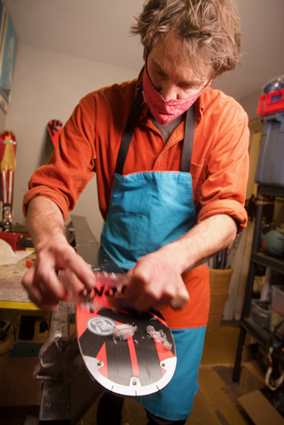You nailed a rock. You lose every race. You skid on firm snow. You haven’t waxed or sharpened your skis in weeks. Months? Whatever the reason, it’s time for a tune.
But what does that mean? Can you DIY it? If not, how do you choose a good shop and what should you ask for? We’ve laid out a guide to help navigate the way to healthier-looking skis.
Take a good look at your ski bases. You can fix the gouges and rough-’n’-rusty edges yourself, but it’s time consuming and hard to do a good job. Our advice: take it to the pros. If there’s no damage to bases and edges are pretty clean, maybe you can save the money for après beer and do it yourself.

DIY
For $150 you can set yourself up to wax and sharpen your own skis. All you need is an iron (anything without steam holes will work) and scraper, a sharpening tool, a workbench with vises to hold skis steady and ventilation.
• Edges first: With a mill bastard file, carefully clean up larger nicks and minor rust spots. Follow up with a ski-specific file, like the Base Beast. It latches onto the ski to maintain the right edge angle. Push it up and down both sides of all edges until running a fingernail over the edge scrapes white. With a softer stone dull the tip and tail areas a little. Give the base a wipe with a rag or paper towel.
• Wax on and off: Pick an appropriate wax for the temperatures you’ll be skiing in. With a warm iron, heat up the wax and either drip drops every few inches down the ski or wipe it on tip to tail. Run the iron over the whole ski, melting the wax into a smooth, even layer. It helps if you sing or whistle. A few tips: you don’t need a lot of wax; keep the iron moving to prevent heat damage; and turn the iron down or off when it smokes.
• Scrape and texture: Let the wax cool completely before running a Plexiglas scraper down the edges. Now scrape the excess wax off the base, starting at the tip and running to the tail. You can leave it here, or add some texture to the base by brushing the ski—tip to tail again—with a horsehair brush. The micro lines help the ski slide faster.
PROS
Not all tuners are equal. Read online reviews, ask an instructor or race coach for a recommendation, and do your own investigating. If the shop space is dirty or disorganized and they don’t have a machine grinder, keep looking.
• Ready to order: When you’ve found a good shop, go in prepared. Just like ordering take-out, it’s best to know what you want before you walk in the door. Take a look at the bases and edges and then remember a few terms. If it’s all new, don’t be intimidated to ask for advice.
• Stone grind: A machine filing system that adds a textured pattern to the base of the ski. It helps skis slide faster and perform better. Higher-end skis come with texture already etched in, but it wears off over time and with base grinding (see next). Do it once a season at most.
• Base grind: A belt sandpaper system that shaves a layer of base material off the ski. Ask for it after most base repair work and if you have damaged or rusty edges.
• Edge sharpen: Some high-tech shops will have a machine that automatically sharpens edges. That’s fine, especially if you’re getting base work done. If your bases look mint, ask for a hand sharpen to preserve the longevity of your skis. Just know you might be charged more for it. Either way, sharpen skis every five ski days.
Angles: Ski edges may look 90 degrees, but are usually one degree off on both sides. If you don’t ask for anything else, that’s what most shops will give you, but it’s always worth checking. For high-performance carving, ramp up to two degrees, but don’t go any further.
Detune: It may sound counterintuitive, but make sure the shop takes the extra step of dulling the edge at the tip and tail. Without it you may struggle to initiate and release turns.
• Wax type: The best shops will ask when you’re going to ski next and match the wax to the forecast temperature. Most shops will just slap on a universal wax that’s okay in a wide range of conditions. You can ask for something specific. Reapply wax every five ski days at minimum or when temperatures change.
from December/January 2021 issue



